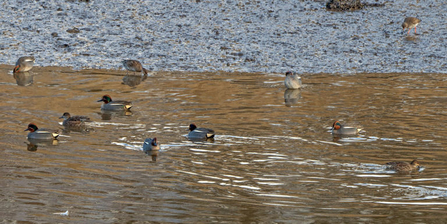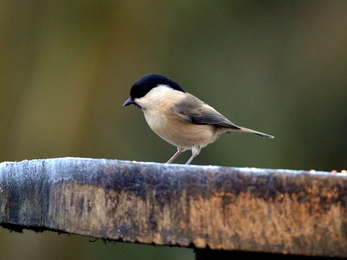December saw the bird feeders busy with all the common yet amazingly colourful small birds that frequent the site, from coal tits, blue tits and long tailed tits to goldfinches and occasional redpoll to name just a few. The remarkably similar marsh tit and rarer willow tit are both found at Low Barns. With help from our regular birders I’m working on being able to tell them apart, wish me luck! People who haven’t been to Low Barns are often amazed by how many species can be seen in just five minutes on the feeders at west hide. Photographers are continually frustrated by how fast some of the shyer species can be, but when they are treated to a fly by from a hungry sparrow hawk they understand why!
Winter wildlife at Low Barns
In early January I took a walk round the site updating “what’s on” posters in the hides and taking a good look at the birds on the main lake. A few gadwall lingered still, numbers were higher in November. Some might consider these ducks plain, but I would say on close inspection you’ll find them to be a beautiful, elegant duck. The size of a mallard the male is grey, black and white. Goldeneye and tufted duck are constantly diving after small fish and aquatic inverts. Males of both species are black and white with the females a browner version of the same pattern. They are long distance migrants that collect on UK water bodies in winter months and are still increasing in numbers at Low Barns. One or two little grebes are often seen again diving constantly they are also known as dabchicks as they are tiny and look just like a chick with their fluffy rear. Lots of mallard, coot and moorhen are always about along with our pair of mute swans and their signets.
A good number of teal are generally found on Marston Lake but this more secretive duck is often tucked out of sight. Teal is the smallest breading duck in the UK, distinctive in flight due to its size and fast wing beat. On this walk I was treated to an all singing all dancing group of teal. Six male teal swam in front of golden reeds catching the sunlight on their yellow triangular tail patch as they ducked heads and flexed tails up in the air in an attempt to impress one slender brown female, literally caught in the middle of it all. All the while they whistled and swam around her, pushing each other away, dancing in front of her. I was mesmerised, but the duck looked unimpressed…

Teal
These performing ducks are not the only early sign of spring. If, like me, you are regularly outside you will notice other ducks dancing, great tits protesting, chasing off other birds, snow drops appearing, willow catkins beginning to open, dogs mercury shooting up, flying insects buzzing on the warmer morning and morning bird song building. It may still be cold, but spring is in the air!



